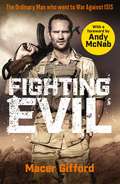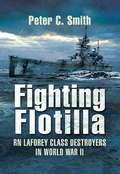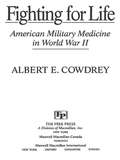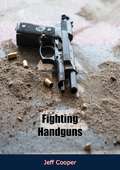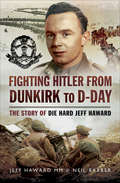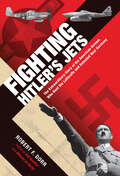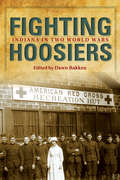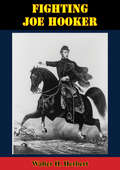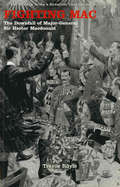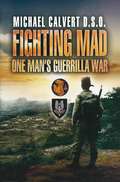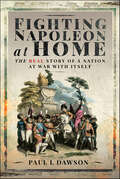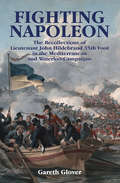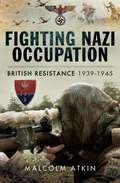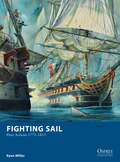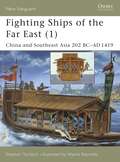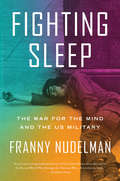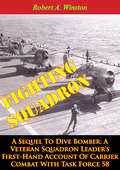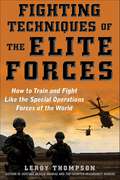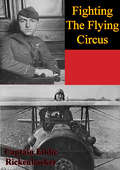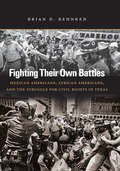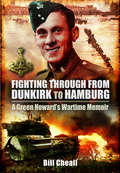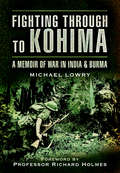- Table View
- List View
Fighting Evil: The Ordinary Man who went to War Against ISIS
by Macer GiffordA visceral, riveting, no-holds-barred military memoir told from the front line of the war against ISIS with a foreword by Andy McNab. In the summer of 2014 the world watched in horror as the black flag of ISIS swept all before it. Mosul, the second largest city in Iraq fell, ISIS proclaimed the caliphate and the horror mounted: from the mass murder, rape and enslavement of the Yazidis to the public beheading of journalists by British jihadis. For Macer Gifford it wasn't enough to ask why more wasn't being done, he knew he had to act. So, he left his job in the city, split from his girlfriend and a few weeks later found himself illegally crossing the border into Syria to join the Kurdish YPG in their fight against the savagery of ISIS.Macer Gifford became one of longest serving British International Volunteers and one of the only few to be promoted to be a Commander in the YPG. He fought alongside the Kurds (and their Syrian Allies) for three long tours of duty from the dawn of the caliphate all the way to its military defeat in the ruins of Raqqa in 2017, sniping at the final deadly wave of suicide bombers as they burst from the rubble. Along the way, he made - and lost - many friends. This is the only complete account of the war against the Caliphate by the Kurds and the remarkable and often eccentric band of international volunteers who fought alongside them.
Fighting Flotilla: RN Laforey Class Destroyers in World War II
by Peter C. SmithThe Laforays were the largest, most powerfully armed and successful ships of this type to see frontline action with the Royal Navy in WWII. They were also the handsomest warships to see service and presented a perfect combination of power and speed. They were assigned to the most dangerous theaters of war including Force H, sailing between Gibraltar and Malta, from where they operated against the German supply lines to North Africa. They escorted minelayers into the German backyard in the North Sea and their convoy escort work in the North Atlantic proved them to be highly effective hunter killers of the U-Boat packs that threatened every cargo ship carrying vital supplies to the UK. Such was the pace of their war, that out of the eight ships of the class only one survived the war.The book also includes chapters on their origin, planning and building, wartime operations and indices cover weapon systems, general fittings and complements and battle honors for each ship in the class.
Fighting For Life: American Military Medicine in World War II
by Albert E. CowdreyFought on almost every continent, the Second World War confronted American GIs with unprecedented threats to life and health posed by combat on Arctic ice floes and African deserts, steamy island jungles and remote mountain villages, the stratosphere and the depths of the sea. Service men were assaulted by frostbite, malaria, shrapnel, and landmines. But the demands of war provoked unparalleled medical advances in the years 1941-45, as well. In a war that unleashed the technology of destruction as no previous conflict had, the tale of those whose duty it was to save lives in World War II, not destroy them, has remained untold. Now, award-winning author Albert Cowdrey has written the first comprehensive history of one of the most important yet underappreciated weapons of World War II - America's extraordinary military medicine. Cowdrey tells the remarkable story of how American units developed and implemented new technology under dire pressures, succeeding so brilliantly that World War II became the first American war in which more men died in combat than of disease. Penicillin brought the antibiotic revolution to the battlefield, air evacuation plucked the wounded from jungles and deserts, and a unique system brought blood, still fresh from America, to our soldiers all over the world. Surgeons working just behind the front lines stabilized the worst cases, while physicians and public health experts suppressed epidemics and cured exotic diseases. Psychiatrists, nurses and medics all performed heroic feats amidst unspeakable conditions. Together, these men and women improvised medical miracles on the battlefield that could not have been imagined by practitioners in peacetime. Cowdrey recalls those triumphant years when Americans, blessed with the skill, courage, and dedication of a formidable medical fighting force, achieved a spectacular victory.
Fighting France: From Dunkerque to Belport (Hesperus Modern Voices)
by Edith Wharton Colm TóibínAs nuanced in her observations of human behavior as she is in her vivid depictions of French landscape and architecture, Wharton fully exploited her unique position as consort to Walter Barry, president of the American Chamber of Commerce in Paris, which allowed her unparalleled access to life in the trenches. Sensitive without sentimentality, and offering a valuable and extremely rare female perspective of a war dominated by the male viewpoint, this series of articles is nothing less than an inspirational testament to the strength of the human spirit at a time of the greatest adversity.
Fighting Handguns: History, Adventure And Romance Of Handguns From The Muzzle Loader To Modern Magnums
by Jeff CooperIn Fighting Handguns, author Jeff Cooper not only takes the reader through the development of this weapon from its beginnings in mid-16th-century Europe through the various iterations of single- and double-action revolvers and semiautomatic pistols, he also discusses some important aspects of carrying and shooting a fighting handgun under combat conditions.“For good or ill, man is a fighting animal. While most feel that this is an unmitigated evil, it may, like most aspects of nature, have its positive side. Certainly man’s combative nature is responsible for most of the massive tragedy of history, but it’s possible that history of any sort just wouldn’t have happened had it not been characteristic of the race to struggle against its environment. And man’s environment, of course, includes man. A placid, gentle, contented creature—a koala, for instance—is nice to contemplate but does not progress, and if it encounters a challenge it simply dies. Whether progress, at the price of a fighting disposition, is worth it is a question, but it’s a bit on the academic side. Man is the way he is, and gets along as he must. Being human, we are involved in strife. Much as we may deplore this, we must master the techniques of strife or perish.“This book is devoted to one of these techniques—the one-hand firearm as used by man against man.”—Jeff Cooper
Fighting Hitler from Dunkirk to D-Day: The Story of Die Hard Jeff Haward
by Jeff Haward Neil BarberFighting Hitler From Dunkirk to D-Day is the compelling story of a man belonging to a group of which there are now very few survivors. Jeff Haward MM is a pre-war Territorial Army soldier who enlisted merely for something to do in the evenings. Consequently, he fought throughout the entirety of the Second World War. Jeff is a 'Die Hard', the historic name given to men of the famous Middlesex Regiment. He joined the 1/7th Battalion, a machine-gun battalion, equipped with the British Army's iconic Vickers medium machine gun.Following evacuation from Dunkirk, the 1/7th, while refitting and re-equipping, carried out coastal defence duties in preparation for the German invasion. So desperate was the situation that on sentry duty, the one rifle per section had to be handed to the next sentry, along with the only ammunition available three rounds!In 1941, they were attached to the famous 51st Highland Division. The less than enthusiastic welcome from the Jocks gradually evolved into respect following the Middlesex's performance at El Alamein and the subsequent campaigns in North Africa, Sicily, Normandy and North West Europe.Following the Reichswald battle, in March 1945, Jeff was surprised to hear that he had been awarded the Military Medal for bravery and was subsequently awarded the ribbon by none other than Field Marshal Sir Bernard Montgomery.Jeff Haward's experiences, those of a normal soldier, make fascinating reading and throw new light on the use of such Vickers gun battalions during the war.
Fighting Hitler's Jets: The Extraordinary Story of the American Airmen Who Beat the Luftwaffe and Defeated Nazi Germany
by Robert F. DorrFighting Hitler's Jets brings together in a single, character-driven narrative two groups of men at war: on one side, American fighter pilots and others who battled the secret “wonder weapons” with which Adolf Hitler hoped to turn the tide; on the other, the German scientists, engineers, and pilots who created and used these machines of war on the cutting edge of technology. Written by Robert F. Dorr, renowned author of Zenith Press titles Hell Hawks!, Mission to Berlin, and Mission to Tokyo, the story begins with a display of high-tech secret weapons arranged for Hitler at a time when Germany still had prospects of winning the war. It concludes with Berlin in rubble and the Allies seeking German technology in order to jumpstart their own jet-powered aviation programs. Along the way, Dorr expertly describes the battles in the sky over the Third Reich that made it possible for the Allies to mount the D-Day invasion and advance toward Berlin. Finally, the book addresses both facts and speculation about German weaponry and leaders, including conspiracy theorists’ view that Hitler escaped in a secret aircraft at the war’s end. Where history and controversy collide with riveting narrative, Fighting Hitler’s Jets furthers a repertoire that comprises some of the United States’ most exceptional military writing.
Fighting Hoosiers: Indiana in Two World Wars
by Dawn E. BakkenFighting Hoosiers: Indiana in Two World Wars tells the compelling, heartbreaking, and breathtaking stories of some of the hundreds of thousands of Hoosiers who served their country during the First and Second World Wars. Drawn from the rich holdings of the Indiana Magazine of History, a journal of state and midwestern history published since 1905, the collection includes original diaries, letters and memoirs, as well as research essays—all of them focused on Hoosiers in the two world wars. Readers will meet Alex Arch, a Hungarian-born immigrant who was the first American to fire a shot in World War I; Maude Essig, a nurse serving with the American Red Cross in wartime France; Kenneth Baker, a soldier in the Army Signal Corps, who crawled across French fields (sometimes over and around dead bodies) to lay phone lines for military communications; and Bernard Rice, a combat medic who witnessed the liberation of the Dachau concentration camp in 1945. Indiana's brave men and women like these have served with distinction in the armed forces since the earliest days of the Indiana Territory. Fighting Hoosiers offers a compelling glimpse at some of their remarkable stories.
Fighting Joe Hooker
by Walter H. Hebert"I have placed you at the head of the Army of the Potomac. Of course I have done this upon what appear to me to be sufficient reasons. And yet I think it best for you to know that there are some things in regard to which, I am not quite satisfied with you."With this opening sentence in a two-page letter from Abraham Lincoln, Union general Joseph Hooker (1814-79) gained a prominent place in Civil War history. Hooker assumed command of an army demoralized by defeat and diminished by desertion. Acting swiftly, the general reorganized his army, routed corruption among quartermasters, improved food and sanitation, and boosted morale by granting furloughs and amnesties. His hour of fame and the test of his military skill came in the May 1863 battle of Chancellorsville. It was one of the Union Army's worst defeats; shortly thereafter Hooker's resignation was accepted.This definitive biography of a man who could lead so brilliantly and yet fall so ignominiously remains the only full-length treatment of Hooker's life. His renewal as an important commander in the western theater during the Chattanooga and Atlanta campaigns is discussed, as is his life before and after his Civil War military service.--Print Ed.
Fighting Mac: The Downfall of Major-General Sir Hector Macdonald
by Trevor RoyleOn a spring morning in 1903, Major-General Sir Hector Macdonald, one of Britain's greatest military heroes, took his life in a hotel room in Paris. A few days later he was buried hastily in an Edinburgh cemetary as his fellow countrymen tried to come to terms with the fact that one of Scotland's most famous soldiers had ended his life rather than face charges against his character.The suicide and its aftermath created a national scandal and one which still reverberates long after those dramatic events - it is now clear that the official files dealing with his case, the papers of the Judge Advocate have been destroyed. Macdonald or 'Fighting Mac' as he was known to an adoring public, was no ordinary soldier. A crofter's son who had risen from the ranks in the Victorian army, he covered himself with glory during a long and successful military career and in 1898 was widely acknowledged as the true hero of the Battle of Omdurman, which cemented British Imperial rule in Anglo-Egyptian Sudan. Everything lay at his feet - a knighthood, honours, the respect of fellow generals such as Roberts and Kitchener - but Macdonald's career came to a shocking full stop when he stood accused of homosexuality and was ordered to face a court martial. Unable to come to terms with the disgrace, he committed suicide. That should have been the end of his story but so powerful was the myth created by Fighting Mac that people refused to believe he was dead. Soon rumours were circulating that Macdonald had faked his death and had adopted the persona of a prominent Prussian officer, the future Field Marshal August con Mackensen, one of Germany's great leaders during the First World War. FIGHTING MAC tells the true story behind his disgrace and sheds new light on the myths....
Fighting Mad: One Man's Guerrilla War
by Michael CalvertMichael Calvert was one of the legendary figures of the Second World War. He hit the headlines as 'Mad Mike' after the first Chindit campaign in 1943, with a reputation as a tough and daring leader of guerrilla troops. He was one of the first men selected for the Chindits by the controversial General Orde Wingate. He became Wingate's right-hand man - both in fierce jungle fighting and in battles against stick-in-the-mud staff officers. His speciality was penetrating behind enemy lines. Mad Mike fought in the snow and ice of Norway, in the steaming jungles of Burma, and on the battlefields of Europe where in 1945 he commanded the crack Special Air Service Brigade.
Fighting Napoleon at Home: The Real Story of a Nation at War With Itself
by Paul L. DawsonFrom the sun-baked sierras of Spain, through the stormy waters off Cape Trafalgar to the muddy and bloody fields of Waterloo, Britain’s soldiers and sailors were notching up victories which set the country on the path to becoming the greatest power on the planet. We like to imagine the country was unified against a common enemy, France, and the Tyrant of Europe – Napoleon. Yet if we scratch the surface, we find a nation not just at war with France but with itself. The great successes of Wellington and Nelson, and the glamour of Regency London, cover over the cracks of a divided society, of riots across the industrial north and widespread political opposition. Huge swathes of the country hated the war, booed and hissed at soldiers and ‘lobbed turds’ at the Scots Greys in Halifax. There were repeated ‘Peace Petitions’ which sought to stop the war – and even to prevent the British Army fighting at Waterloo. Armed Associations of gentlemen volunteers and Local Militias led the call to close down the debate on social and democratic reform, while on the other hand thousands of English reformers heeded the call from France and hundreds actually headed to France, with many thousands more believing that the time had come, when its young men were needed to fight for King and Country, for reform. The burgeoning middle class had no vote in parliament; rapidly expanding industrial towns and cities had no MPs, yet small villages – pocket boroughs – often had two. The burden of taxation fell on those least able to afford it; enclosure of common land; corn laws; restrictions on the freedom of expression; the endless killing, all fed into an undercurrent of political dissent that was ideologically opposed to the loyalist cause. It was a battle for the very sole of Britain. For the first time, the shocking reality of life in Britain, during what is often portrayed as being its greatest era, is told through diaries, letters, and newspaper comments. Fighting Napoleon at Home is a startling portrayal of the society from which the soldiers and sailors were drawn and exactly what it was they were fighting to defend. It will become essential reading for anyone attempting to understand why Britain’s aristocracy had to stop Napoleon at any cost and suppress the dangerous ideals of liberté, égalité, fraternité.
Fighting Napoleon: The Recollections of Lieutenant John Hildebrand 35th Foot in the Mediterranean and Waterloo Campaigns
by Gareth Glover&“These lively and entertaining memoirs provide an intriguing counterpoint to Wellington&’s better-known operations in the Iberian Peninsula&” (Julian Stockwin, author of the Thomas Kydd series). It is often forgotten that Britain&’s struggle against Napoleon ranged across the continents, and the extensive operations of the Royal Navy and the British Army in the Mediterranean were key battlegrounds in this prolonged war of attrition. Even when Napoleon considered himself the master of Europe, he was unable to control the Mediterranean. Lt. John Hildebrand arrived in the Mediterranean as part of the garrison of Malta in 1810. He was then involved in the defense of the island of Sicily; the campaign to capture the Ionian Islands; the siege of Ragusa; and the Occupation of Corfu. With the war ending in 1814, John and his regiment returned home, only to be sent to Belgium when Napoleon escaped from Elba in 1815. The regiment was not involved at Waterloo, but was at Hal, where it guarded Wellington&’s flank during the battle. He then marched to Paris with the army. &“Napoleonic students will enjoy this refreshingly different slant on Napoleonic warfare.&” —Stuart Asquith, author of Stuart Asquith&’s Wargaming 18th Century Battles &“Essential reading for military historians and collectors of Napoleonic War era artifacts and militaria.&” —The Armourer Incorporating Classic Arms & Militaria
Fighting Nazi Occupation: British Resistance 1939–1945
by Malcolm Atkin&“Everyone knows about the Home Guard but what about the other Secret Intelligence Services (SIS and M16)? You can read about them in [this book].&” —This England When Winston Churchill made his &“we shall never surrender&” speech in 1940, he was speaking in the knowledge that Britain&’s Secret Intelligence Service was planning a civilian British resistance movement to mobilize after the country had been occupied. Britain&’s planning for clandestine warfare developed out of a fierce battle between the Secret Intelligence Service and the War Office for the control of guerrilla warfare and conflicting ideas over the legitimacy of armed civilians. A multi-layered system of secret organizations was the result. The Auxiliary Units are the best known of these &“ungentlemanly&” forces, but in this perceptive new study based on painstaking original research, Malcolm Atkin clearly demonstrates that they were never intended as a resistance organization. Instead, they were designed as a short-term guerrilla force, whilst their Special Duties Branch was designed to spy on the British public as much as any Nazi invader. Meanwhile, deep in the shadows, was the real resistance organization—Section VII of SIS. Malcolm Atkin&’s conclusions will cause controversy among military historians and will change our understanding of the preparations made in Britain to resist Nazi occupation in the Second World War. &“[A] detailed yet accessible historical study.&” —ProtoView
Fighting Sail - Fleet Actions 1775-1815
by Peter Dennis Ryan MillerIn the years between 1776 and 1815, grand square-rigged sailing ships dominated warfare on the high seas. Fighting Sail is a tabletop wargame of fleet battles in this age of canvas, cannon, and timbers. Players take on the roles of fleet admirals from one of eight different national fleets: America, Britain, France, Spain, The Netherlands, Portugal, Russia and Sweden in battles ranging from the American War of Independence to the Napoleonic Wars and the War of 1812. Each fleet has access to different ships, tactics, and command personalities - each with its own strengths and weaknesses. Offering a unique blend between detail and simplicity, the scenarios included enable the recreation of historic actions or 'what-if' scenarios. Join the battle and experience the adventurous age of the fighting sail!
Fighting Ships of the Far East
by Stephen Turnbull Wayne ReynoldsFighting Ships of the Far East (1) adds enormously to the hitherto small corpus of knowledge about a fascinating and little known subject. Using detailed descriptions, accurate cutaway plates and reliable historical examples, this book covers the history of Chinese ship design and naval warfare from the beginning of the Han dynasty to the first few years of the Ming dynasty. The epic battle of Lake Poyang in in 1363, won by the man who was to become the first Ming Emperor, is also detailed.
Fighting Sleep: The War for the Mind and the US Military
by Franny NudelmanHow the military used sleep as a weapon—and how soldiers fought backOn April 21, 1971, hundreds of Vietnam veterans fell asleep on the National Mall, wondering whether they would be arrested by daybreak. Veterans had fought the courts for the right to sleep in public while demonstrating against the war. When the Supreme Court denied their petition, they decided to break the law and turned sleep into a form of direct action. During and after the Second World War, military psychiatrists used sleep therapies to treat an epidemic of “combat fatigue.” Inducing deep and twilight sleep in clinical settings, they studied the effects of war violence on the mind and developed the techniques of brainwashing that would weaponize both memory and sleep. In the Vietnam War era, radical veterans reclaimed the authority to interpret their own traumatic symptoms—nightmares, flashbacks, insomnia—and pioneered new methods of protest. In Fighting Sleep, Franny Nudelman recounts the struggle over sleep in the postwar world, revealing that sleep was instrumental to the development of military science, professional psychiatry, and antiwar activism. Traversing the fields of military and mainstream psychiatry, popular and institutional film, documentary sound technology, brain warfare, and postwar social movements, she demonstrates that sleep—far from being passive, empty, or null—is a site of contention and a source of political agency.
Fighting Squadron, A Sequel To Dive Bomber: A Veteran Squadron Leader’s First-Hand Account Of Carrier Combat With Task Force 58
by Lt.-Cmdr. Robert A. WinstonAn engaging memoir of Lieutenant-Commander Robert A. Winston's wartime experiences as squadron leader of Fighting Squadron 31, which succeeded in shooting down more enemy aircraft than any other squadron serving on light carriers then in action.Robert A. Winston was born in Washington, Indiana, in 1907 and graduated from Indiana University. He worked for The New York Times and The New York News for five years before starting flight training with the navy in 1935. He flew in fighting squadrons on both coasts and as an instructor at Pensacola, and he wrote about his initial aviation training in Dive Bomber, published in 1939 when Winston held the rank of lieutenant. In his second book, Aces Wild, he chronicled his experiences in Europe during 1939-40 as a test pilot accompanying a consignment of fighters destined for Finland. Back on active duty in the United States, he served as a flight instructor, then in the public relations office in Washington, D.C. After the attack on Pearl Harbor he was assigned to combat duty in the Pacific, which he recounts in Fighting Squadron, published in 1946 when Winston was a commander. At the end of the war he was serving on Admiral Nimitz's staff on Guam. From there he moved to Stockholm, where he served as the naval air attaché.
Fighting Techniques of the Elite Forces: How to Train and Fight Like the Special Operations Forces of the World
by Leroy ThompsonLearn the trade secrets of special operatives. It is easy to visualize special operations troops as men in camouflage with painted faces, lurking in the shadows of modern warfare. But the truth is far more complex—and enthralling. A wide array of skills, both physical and cerebral, combines to make up the modern elite soldier. Fighting Techniques of the Elite Forces not only shows the road down which the specialist must travel to reach his place as one of the world's fighting elite, it details the equipment he uses to carry out his missions and the actual techniques he employs. Themed chapters and a wealth of illustrations explain everything you need to know about the formidably trained warriors of the British and Australian SAS, US Army Rangers, Navy SEALs, the French GIGN, and more. Learn how to select a drop zone for parachute insertions or how to execute a High Altitude High Opening (HAHO) insertion when you are twenty miles' distance from your objective. Find out how combat swimmers launch from submarines to carry out beach reconnaissance prior to an invasion. Understand the special considerations and knowledge required to fight and, more importantly, survive in such hostile environments as jungle, desert, or mountain. Discover how today's special operative must master skills as diverse as horsemanship and the compact computer, or how to kill silently with a knife or laser designator.Fighting Techniques of the Elite Forces is a must-have for anyone interested in the covert world of elite forces; it will provide the key to understanding what makes the specialist soldier so very "special."
Fighting The Flying Circus [Illustrated Edition]
by Captain Eddie RickenbackerIncludes Aerial Warfare During World War I Illustrations Pack with 115 maps, plans, and photos.Captain Rickenbacker, originally from Ohio, was best known as one of the Commanders of the 94th "Hat-in-the-Ring" Squadron, a crack unit of pilots which included many former members of the famed Lafayette Escadrille. The 94th ended the war in France with the highest number of air victories of any American squadron. Captain Rickenbacker himself was credited with 26 aerial victories all within the last six months of the war, he was decorated with the Congressional Medal Of Honor for his inspirational leadership and fearless flying.
Fighting Their Own Battles: Mexican Americans, African Americans, and the Struggle for Civil Rights in Texas
by Brian D. BehnkenBetween 1940 and 1975, Mexican Americans and African Americans in Texas fought a number of battles in court, at the ballot box, in schools, and on the streets to eliminate segregation and state-imposed racism. Although both groups engaged in civil rights struggles as victims of similar forms of racism and discrimination, they were rarely unified. In Fighting Their Own Battles, Brian Behnken explores the cultural dissimilarities, geographical distance, class tensions, and organizational differences that all worked to separate Mexican Americans and blacks. Behnken further demonstrates that prejudices on both sides undermined the potential for a united civil rights campaign. Coalition building and cooperative civil rights efforts foundered on the rocks of perceived difference, competition, distrust, and, oftentimes, outright racism. Behnken's in-depth study reveals the major issues of contention for the two groups, their different strategies to win rights, and significant thematic developments within the two civil rights struggles. By comparing the histories of these movements in one of the few states in the nation to witness two civil rights movements, Behnken bridges the fields of Mexican American and African American history, revealing the myriad causes that ultimately led these groups to "fight their own battles. "
Fighting Through from Dunkirk to Hamburg: A Green Howard's Wartime Memoir
by Bill CheallA British infantryman shares his harrowing story of life on the frontlines of WWII, from the North African Campaign to the invasion of Germany. In April 1939, when Bill Cheall joined the famous Yorkshire infantry regiment known as the Green Howards, he could not have imagined the drama, trauma, rewards and anguish that awaited him. But he recounts it all here, in this vivid memoir of service and courage under fire. As a Green Howard, Cheall was on the receiving end of the Nazis' Blitzkrieg and was evacuated exhausted. Then, courtesy of the Queen Mary, he shipped off to North Africa as part of Field Marshal Bernard Montgomery's Eight Army. After their victory in Tunisia, Cheall went on to the invasion of Sicily. The Green Howards then returned to England to be in the vanguard of the Normandy Landings on Gold Beach—where Cheall was wounded. Once he recovered, Cheall returned to the war zone and finished the war as a Regimental Policeman in occupied Germany. It is a remarkable story told with modesty, humor, and an eye for detail.
Fighting Through to Hitler's Germany: Personal Accounts of the Men of 1 Suffolk 1944–45
by Mark Forsdike&“The real story of how the Second World war was won in Europe . . . Packed with the personal stories of the men who were there.&” —Clash of Steel After landing on D-Day, 1st Battalion, The Suffolk Regiment fought through France, Holland and into Germany as part of the 3rd (British) Infantry Division. Ever cheerful, the Battalion were opposed by an increasingly ruthless enemy determined to deny the invader their homeland. As the campaign developed, 1 Suffolk acquired an enviable reputation for getting the job done with the minimum of fuss. Inevitably casualties mounted up and, of the 850 who landed on D-Day, just 178 were still serving on VE-Day; 215 had been killed and 640 wounded. The Battalion&’s success was due in large measure to fine leadership and all four commanding officers went on to enjoy distinguished careers. But without the stalwart fighting spirit and comradeship of all ranks none of the Battalion&’s achievements would have been possible. This fine book draws on the testimonies of officers and men who served in this historic campaign. Recognition of the fighting record of 1 Suffolk is long overdue and the author is to be congratulated for pulling together these inspiring first-hand accounts along with many previously unpublished photographs.A Soldier Magazine Top Read of the Year&“Brings life to the story of in this case World War II, and gives an insight into what this war was like. The author deserves praise for the way he has presented the words of these men, as it makes for a very engaging read.&” —Armorama
Fighting Through to Kohima: A Memoir of War in India and Burma
by Michael LowryA decorated British officer&’s wrenching and inspiring firsthand account of the worst battle of the Burma campaign. Lt. Col. Michael Lowry MC MBE, was awarded the Military Cross for his role in the desperate defensive action at Kohima, considered the worst of the campaign in Burma. After joining up in 1939 with the Queen&’s Royal Regiment, Lowry was posted to the North West Frontier of India, where he cut his teeth chasing gangs of Pathan bandits for two years. As the Japanese advanced into Burma, Lowry found himself fighting in the Arakan region, where his battalion was cut off by the Japanese for three weeks. Having survived that, next came the action at Kohima—where in the course of one week Lowry&’s battalion lost 173 members. Lowry was seriously wounded in the conflict but fortunately lived to tell the tale. This is a fascinating and inspiring book, one of the most action-packed memoirs of the war in Burma ever published.
